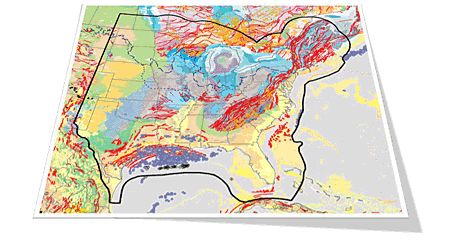CEUS-SSC
The Central and Eastern United States Seismic Source Characterization for Nuclear Facilities (CEUS-SSC) Project was conducted from April 2008 to December 2011 to provide the nuclear industry a new, regional seismic source model for use in conducting probabilistic seismic hazard analyses (PSHAs) for nuclear facilities. PSHA is used as a method for accounting for uncertainty in seismic design and in calculating seismic risk. Unlike previous seismic hazard studies, the CEUS-SSC Project was sponsored through an industry-government partnership. The study was conducted using the Senior Seismic Hazard Analysis Committee (SSHAC) Study Level 3 assessment process. The SSHAC process ensures consideration of the knowledge and uncertainties of the larger technical community within a robust and transparent framework. The objective of the CEUS-SSC project was to develop an up-to-date seismic source characterization model for the CEUS that included:
- Evaluation: Consideration of the data, models and methods that have been proposed by the larger technical community
- Integration: Representation of the center, body and range of technically defensible interpretations
- Incorporation of uncertainties
- Consideration of an up-to-date database
- New approaches to systematically document and evaluate all data considered for increased transparency
- Engagement of all stakeholders and a robust peer review
The CEUS-SSC project provides a new seismic source model.
Benefits[edit]
Industry and government share a common need for an updated CEUS-SSC Model. The commercial nuclear industry needs the new CEUS-SSC Model to support PSHAs for future reactor license applications; the U.S. Nuclear Regulatory Commission (NRC) benefits from the CEUS-SSC Model during its review of Early Site Permit (ESP) and Construction and Operating License (COL) applications and the U.S. Department of Energy (DOE) needs the model to support PSHAs to meet design and periodic review requirements for its current and future nuclear facilities.
Some of the specific benefits of the model are:
- Consistency: A regional source model allows for consistent input into a PSHA
- Stability: Proper and thorough characterization of the larger technical community's knowledge and uncertainties coupled with the involvement of the technical community, regulators, and oversight groups best achieves stability
- Greater Longevity: Representing the center, body, and range of technically-defensible interpretations at the time of the study means that as new information is gained and various interpretations evolve as a result, the current thinking at any point in time is more likely to have been addressed in the study
- Cost and Schedule Savings for the commercial nuclear industry and DOE to prepare PSHAs
- Advancement of Science: The CEUS-SSC Project provides new data, models and methods
Project Updates[edit]
The CEUS-SSC website was activated in January 2012. Provision was made when constructing the website to incorporate updates which become available. This site contains background information from the CEUS SSC project that includes the report and a section for updates. Website updates shall fall under two categories:
- Category 1: Correction to fix a parameter and bookkeeping changes which may require errata sheets. Bookkeeping changes are minor changes to correct clear mistakes in the CEUS-SSC model and report. Typos and mis-labeled figures are other examples. No Senior Seismic Hazard Analysis Committee (SSHAC) assessment process is required for this category.
- Download Category 1 Update dated June 27, 2012
- Category 1 Update dated June 29, 2015 (EPRI Report # 3002005684)
- In mid-2014, an error was identified in the published maximum magnitude (Mmax) distributions for a number of the CEUS seismotectonic model zones. The error was promptly communicated to utility seismic hazard representatives, NRC and DOE representatives, and key technical experts involved in the development of the CEUS SSC model. EPRI published a report (EPRI Product ID: 3002005684) to document reviews performed to determine the extent of condition of the Mmax error and the potential impacts of the error on seismic hazard calculations. The EPRI report documents the originally published and corrected Mmax values and the results of evaluations performed to assess impacts on the recurrence parameters, seismic hazards, and ground motion response spectra (GMRS) estimates at two sites within or near the affected seismotectonic zones. The evaluations were performed in close consultation with the three CEUS SSC sponsors (NRC, DOE, and EPRI) and represent consensus conclusions.
- Minor Mmax distribution corrections were identified for the PEZ-N, PEZ-W, IBEB, SLR and MidC A through D seismotectonic zones. Sensitivity studies at two sites showed there are negligible impacts on the recurrence parameter results as well as calculated seismic hazard and GMRS results. These impacts are within the level of precision associated with the standard reporting of GMRS, which leads to the conclusion that it is NOT necessary to incorporate the corrected Mmax values into the CEUS model or the published CEUS SSC report.
- Category 2: All other updates approved for posting by the Sponsors (DOE, EPRI and NRC).
- There are no Category 2 updates available at this time.
Posting of Category 1 and Category 2 updates shall be approved by the Sponsors (DOE, EPRI and NRC).
